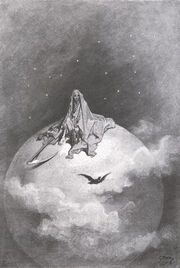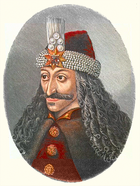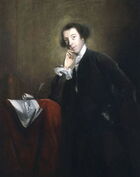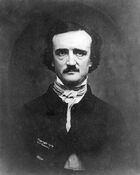
An Illustration of Poe's "The Raven" by Gustave Doré
<templatestyles src="Hlist/styles.css"></templatestyles><templatestyles src="Module:Sidebar/styles.css"></templatestyles>
| Speculative fiction |
|---|
| Alternate history |
| Fantasy fiction |
|
| Horror fiction |
|
| Science fiction |
|
| Other |
|
|
|
| <templatestyles src="Hlist/styles.css"></templatestyles><templatestyles src="Module:Navbar/styles.css"></templatestyles> |
Horror is a genre of speculative fiction which is intended to, or has the capacity to frighten, scare, disgust, or startle its readers or viewers by inducing feelings of horror and terror. Literary historian J. A. Cuddon has defined the horror story as "a piece of fiction in prose of variable length... which shocks or even frightens the reader, or perhaps induces a feeling of repulsion or loathing".[1] It creates an eerie and frightening atmosphere. Horror is frequently supernatural, though it can be non-supernatural. Often the central menace of a work of horror fiction can be interpreted as a metaphor for the larger fears of a society.
History[]
Horror in ancient Greece and Rome[]

Athenodorus
The genre of horror has ancient origins with roots in folklore and religious traditions, focusing on death, the afterlife, evil, the demonic and the principle of the thing embodied in the person.[2] These were manifested in stories of beings such as witches, vampires, werewolves and ghosts. European horror fiction became established through works by the Ancient Greeks and Ancient Romans. In Greek mythology, Prometheus was a Titan who was the inspiration for the title of Frankenstein, or The Modern Prometheus. Prometheus' earliest known appearance is in Hesiod's Theogony.[3] However, the story of Frankenstein was influenced far greater on the story of Hippolytus. Asclepius revived Hippolytus from death. Euripides wrote plays based on the story, "Hippolytos Kalyptomenos" and Hippolytus.[4] Plutarch's "The Lives of the Noble Grecians and Romans: Cimon" describes the spirit of the murderer, Damon, who himself was murdered in a bathhouse in Chaeronea.[5] Pliny the Younger describes Athenodorus Cananites who bought a haunted house in Athens. Athenodorus was cautious since the house was inexpensive. As Athenodorus writes a book about philosophy, he is visited by an aberration bound in chains. The figure disappears in the courtyard; the following day, the magistrates dig up the courtyard to find an unmarked grave.[6]
Horror in the Medieval Era[]
The establishment of Christianity in Rome was confirmed by the Edict of Milan in 313 A.D., and thus revolutionized the religious landscape of Europe. The revolt by the Goths, the Germanic believers of Gothic paganism, earned them a reputation amongst several early writers and their texts, such as Scriptores Historiae Augustae, Vita Gallienii.[7] The earliest recording of an official accusation of Satanism by the Roman Catholics took place in Toulouse in 1022 A.D. against a couple of clerics.[8] Werewolf stories grew in popularity in French literature of medieval France. Marie de France wrote one of the twelve lais as a werewolf story entitled "Bisclavret".

Vlad III
The Countess Yolande commissioned a werewolf story entitled "Guillaume de Palerme". Anonymous writers penned two werewolf stories, "Biclarel" and "Melion". Much of horror fiction derived itself from the cruelest faces in world history, particularly those who lived in the fifteenth-century. "Dracula" can be traced to the Prince of Wallachia Vlad III whose alleged war crimes were published in German pamphlets in the late Fifteenth Century. The 1499 pamphlet published by Markus Ayrer is most notable for its woodcut imagery.[9] The alleged crimes of the Giles de Rais were said to be the inspiration for "Bluebeard".[10] The vampiress is most notably derived from the real life noblewoman and murderess, Elizabeth Bathory. Elizabeth Bathory in popular culture helped usher in the emergence of horror fiction in the 18th-Century, such as through László Turóczi in his 1729 book, Tragica Historia.[11]
Gothic horror in the 18th century[]

Horace Walpole wrote the first Gothic novel, The Castle of Otranto (1764), initiating a new literary genre.[12]
The Eighteenth century slowly directed the horror genre into traditional Gothic literature. 18th century Gothic horror drew on these sources with the seminal and controversial The Castle of Otranto (1764) by English author Horace Walpole. This marked the first incorporated elements of the supernatural instead of pure realism. In fact, the first edition was published disguised as an actual medieval romance from Italy discovered and republished by a fictitious translator.[12] Once revealed as contemporary, many found it anachronistic, reactionary, or simply in poor taste—but it proved to be immediately popular.[12] That first novel of Gothic horror inspired such works as Vathek (1786) by William Beckford, A Sicilian Romance (1790), The Mysteries of Udolpho (1794) and The Italian (1796) by Ann Radcliffe and The Monk (1797) by Matthew Lewis.[12] A significant amount of horror fiction of this era was written by women and marketed at a female audience, a typical scenario being a resourceful female menaced in a gloomy castle.[13]
Horror in the 19th century[]
Mary Shelley by Richard Rothwell (1840–41)

Edgar Allan Poe
The Gothic tradition blossomed into the genre modern readers call horror literature in the 19th century. Influential works and characters that continue resonating with film and cinema today saw their genesis in such works as the Brothers Grimm's "Hänsel und Gretel" (1812), Mary Shelley's Frankenstein (1818), Washington Irving's The Legend of Sleepy Hollow (1820), Jane C. Loudon's "The Mummy!: Or a Tale of the Twenty-Second Century" (1827), Victor Hugo's The Hunchback of Notre Dame (1831), Thomas Peckett Prest's Varney the Vampire (1847), Nathaniel Hawthorne's The Scarlet Letter (1850), the works of Edgar Allan Poe, the works of Sheridan Le Fanu, Robert Louis Stevenson's Strange Case of Dr Jekyll and Mr Hyde (1886), Oscar Wilde's The Picture of Dorian Gray (1890), H. G. Wells' The Invisible Man (1897), and Bram Stoker's Dracula (1897). Each of these novels and novellas created an enduring icon of horror seen in modern re-imaginings on the stage and screen.[14]
Horror in the 20th century[]
The proliferation of cheap periodicals, as early as the turn of the century, led to a boom in horror writing. For example, Gaston Leroux serialized his "Le Fantôme de l'Opéra" before it was a novel in 1910. One writer who specialized in horror fiction for mainstream pulps such as All-Story Magazine was Tod Robbins, whose fiction dealt with themes of madness and cruelty.[15][16] Later, specialist publications emerged to give horror writers an outlet, including Weird Tales[17] and Unknown Worlds.[18]
Influential horror writers of the early 20th century made inroads in these mediums. Particularly, the venerated horror author H. P. Lovecraft, and his enduring Cthulhu Mythos pioneered the genre of cosmic horror, and M. R. James is credited with redefining the ghost story in that era.
The serial murderer became a recurring theme in horror fiction. Yellow journalism and sensationalism of various murderers, such as Jack the Ripper, and lesser so, Carl Panzram, Fritz Haarman, and Albert Fish, all perpetuated this phenomenon. An example of this is found in Charles S. Belden's unpublished 1932 short story, "The Wax Works". The trend continued in the postwar era, partly renewed after the murders committed by Ed Gein. In 1959, Robert Bloch, inspired by the murders, wrote Psycho. The murders committed by Charles Schmid inspired Joyce Carol Oates to publish the short story, "Where Are You Going, Where Have You Been?" In 1969, the crimes of the Manson family further influenced the slasher theme in horror fiction of the 1970s. In 1981, Thomas Harris wrote Red Dragon as the first novel to introduce Dr. Hannibal Lecter. The character is said to be based on the real life Dr. Alfredo Balli Trevino. In 1988, Harris wrote the sequel, The Silence of the Lambs.
Early cinema was inspired by many aspects of horror literature, and early horror cinema started a strong tradition of horror films and subgenres based on horror fiction that continues to this day. Up until the graphic depictions of violence and gore on the screen commonly associated with the 1960s and 1970s slasher films and splatter films, comic books such as those published by EC Comics (famous for series such as Tales From The Crypt) in the 1950s satisfied readers' quests for horror imagery that the silver screen could not provide.[19] This imagery made these comics controversial, and as a consequence they were frequently censored.
Many modern novels claim an early description of the living dead in a precursor to the modern zombie tale, including Dennis Wheatley's "Strange Conflict" (1941), H.P. Lovecraft stories such as "Cool Air," (1925) "In The Vault," (1926) and "The Outsider," (1926). Richard Matheson's novel I Am Legend (1954) would also influence an entire genre of apocalyptic zombie fiction emblematic of the films of George A. Romero.
Contemporary horror fiction[]

One of the best-known contemporary horror writers is Stephen King, known for writing Carrie, The Shining, It, Misery and many more.[20] Beginning in the 1970s, King's stories have managed to attract a large audience, for which he was prized by the U.S. National Book Foundation in 2003.[21] Popular contemporary horror authors include Brian Lumley, James Herbert, Dean Koontz, Clive Barker,[22] Ramsey Campbell,[23] and Peter Straub.
Best-selling book series of contemporary times exist in related genres to horror fiction, such as the werewolf fiction urban fantasy Kitty Norville books from Carrie Vaughn, the erotic Gothic fiction of Anne Rice, and Goosebumps by R.L. Stine. Elements of the horror genre continue to expand outside the genre. The alternate history of more traditional historical horror in a novel such as The Terror exists on bookstore shelves next to genre mash ups such as Pride and Prejudice and Zombies and the historical fantasy and horror comics such as Hellblazer and Mike Mignola's Hellboy. Horror serves as one of the central genres in more complex modern works such as Mark Z. Danielewski's House of Leaves, a finalist for the National Book Award. There are also horror novels for teens, such as The Monstrumologist by Rick Yancey.
Characteristics[]
One of the defining traits of the genre of horror is that it provokes a response; emotional, psychological or physical, within readers that causes them to react with fear. One of H.P. Lovecraft's most famous quotes about the genre is that: "The oldest and strongest emotion of mankind is fear, and the oldest and strongest kind of fear is fear of the unknown."[24] the first sentence from his seminal essay, "Supernatural Horror in Literature".
In her essay "Elements of Aversion", Elizabeth Barrette articulates the need by some for horror tales in a modern world:
The old "fight or flight" reaction of our evolutionary heritage once played a major role in the life of every human. Our ancestors lived and died by it. Then someone invented the fascinating game of civilization, and things began to calm down. Development pushed wilderness back from settled lands. War, crime, and other forms of social violence came with civilization and humans started preying on each other, but by and large daily life calmed down. We began to feel restless, to feel something missing: the excitement of living on the edge, the tension between hunter and hunted. So we told each other stories through the long, dark nights...when the fires burned low, we did our best to scare the daylights out of each other. The rush of adrenaline feels good. Our hearts pound, our breath quickens, and we can imagine ourselves on the edge. Yet we also appreciate the insightful aspects of horror. Sometimes a story intends to shock and disgust, but the best horror intends to rattle our cages and shake us out of our complacency. It makes us think, forces us to confront ideas we might rather ignore, and challenges preconceptions of all kinds. Horror reminds us that the world is not always as safe as it seems, which exercises our mental muscles and reminds us to keep a little healthy caution close at hand.[25]
In a sense similar to the reason a person seeks out the controlled thrill of a roller coaster, readers in the modern era seek out feelings of horror and terror to feel a sense of excitement. However, she adds that horror fiction is one of the few mediums where readers seek out a form of art that forces themselves to confront ideas and images they "might rather ignore ... [to challenge] preconceptions of all kinds."
One can see the confrontation of ideas readers and characters would "rather ignore" throughout literature, in famous moments such as Hamlet's musings about the skull of Yorick and its implications of the mortality of humanity and the gruesome end that bodies inevitably come to. In horror fiction, the confrontation with the gruesome is often a metaphor for the problems facing the current generation of the author.
Stephanie Demetrakopoulos illustrates a common interpretation of one of the benchmarks of the canon of horror literature.[26] Tina Broussard in an annotated bibliography of Dracula surmises Demetrakopoulos' thesis:
This scholarly journal article explores sexuality in Dracula, including overtones of sexuality in the typical aggressive male and female sexuality which is either reflective of the chaste woman or the sexually aggressive female vampire. Demetrakopoulos suggests Dracula was an outlet for Victorian society, breaking through sexual norms with symbolic group orgies, male desire for sexually aggressive women, denial of motherhood, etc. She highlights ways in which the females defy gender boundaries by embodying masculine traits such as intelligence.[27]
It is a now commonly accepted viewpoint that the horror elements of Dracula's portrayal of vampirism are metaphors for sexuality in a repressed Victorian era.[26] But this is merely one of many interpretations of the metaphor of Dracula. Judith Halberstam postulates many of these in her essay Technologies of Monstrosity: Bram Stoker's Dracula. She writes:
[The] image of dusty and unused gold, coins from many nations and old unworn jewels, immediately connects Dracula to the old money of a corrupt class, to a kind of piracy of nations and to the worst excesses of the aristocracy.[28]

Illustration from an 1882 issue of Punch: An English editorial cartoonist conceives the Irish Fenian movement as akin to Frankenstein's monster, in the wake of the Phoenix Park killings.
Menacing villains and monsters in horror literature can often be seen as metaphors for the fears incarnate of a society.
Halberstram articulates a view of Dracula as manifesting the growing perception of the aristocracy as an evil and outdated notion to be defeated. The depiction of a multinational band of protagonists using the latest technologies (such as a telegraph) to quickly share, collate, and act upon new information is what leads to the destruction of the Vampire. This is one of many interpretations of the metaphor of only one central figure of the canon of horror fiction, as over a dozen possible metaphors are referenced in analysis, from the religious to the anti-semitic.[29]
Noël Carroll's Philosophy of Horror postulates that a modern piece of horror fiction's "monster", villain, or a more inclusive menace must exhibit the following two traits:
- A menace that is threatening — either physically, psychologically, socially, morally, spiritually, or some combination of the aforementioned.
- A menace that is impure — that violates the generally accepted schemes of cultural categorization. "We consider impure that which is categorically contradictory"[30]
Scholarship and criticism[]
In addition to those essays and articles shown above, scholarship on horror fiction is almost as old as horror fiction itself. In 1826, the gothic novelist Ann Radcliffe published an essay distinguishing two elements of horror fiction, "terror" and "horror." Whereas terror is a feeling of dread that takes place before an event happens, horror is a feeling of revulsion or disgust after an event has happened.[31] Radcliffe describes terror as that which "expands the soul and awakens the faculties to a high degree of life," whereas horror is described as that which "freezes and nearly annihilates them."
Modern scholarship on horror fiction draws upon a range of sources. In their historical studies of the gothic novel, both Devandra Varma[32] and S.L. Varnado[33] make reference to the theologian Rudolf Otto, whose concept of the "numinous" was originally used to describe religious experience.
Awards and associations[]
Achievements in horror fiction are recognized by numerous awards. The Horror Writer's Association presents the Bram Stoker Awards for Superior Achievement, named in honor of Bram Stoker, author of the seminal horror novel Dracula.[34] The Australian Horror Writers Association presents annual Australian Shadows Awards. The International Horror Guild Award was presented annually to works of horror and dark fantasy from 1995 to 2008.[35][36] The Shirley Jackson Awards are literary awards for outstanding achievement in the literature of psychological suspense, horror and the dark fantastic works. Other important awards for horror literature are as subcategories included within general awards for fantasy and science fiction in such awards as the Aurealis Award.
Alternate terms[]
Some writers of fiction normally classified as "horror" nevertheless dislike the term, considering it too lurid. They instead use the terms dark fantasy or Gothic fantasy for supernatural horror,[37] or "psychological thriller" for non-supernatural horror.[38]
See also[]
<templatestyles src="Module:Portal/styles.css"></templatestyles>
- Related genres
- Crime fiction
- Dark fantasy
- Ghost stories
- Monster literature
- Mystery fiction
- Speculative fiction
- Thriller
- Weird fiction
- Horror convention
- Horror podcast
- LGBT themes in horror fiction
- List of horror films
- List of horror fiction writers
- List of ghost films
- List of horror television programs
References[]
- ↑ Cuddon, J.A. (1984). "Introduction". The Penguin Book of Horror Stories. Harmondsworth: Penguin. p. 11. ISBN 0-14-006799-X.
- ↑ Rosemary Jackson (1981). Fantasy: The Literature of Subversion. London: Methuen. pp. 53–5, 68–9.
- ↑ Hesiod, Theogony 590-93.
- ↑ * Edward P. Coleridge, 1891, prose: full text Archived 12 April 2006 at the Wayback Machine
- ↑ * John Dryden, 1683: full text
- ↑ Pliny the Younger (1909–14). "LXXXIII. To Sura". In Charles W. Eliot. Letters, by Pliny the Younger; translated by William Melmoth; revised by F. C. T. Bosanquet. The Harvard Classics. 9. New York: P.F. Collier & Son.
- ↑ Scriptores Historiae Augustae, Vita Gallienii, 13.8
- ↑ Van Luijk, Ruben (2016). Children of Lucifer: The Origins of Modern Religious Satanism. Oxford: Oxford University Press.
- ↑ Raymond T. McNally and Radu R. Florescu (1972). "In Search of Dracula." Houghton Milton. Pages 8–9."
- ↑ Kiernan, Dr. Jas. G. "Sexual Perversion, and the Whitechapel Murders." The Medical Standard: IV.5. G. P. Engelhard and Company: Chicago.
- ↑ in Ungaria suis cum regibus compendia data, Typis Academicis Soc. Jesu per Fridericum Gall. Anno MCCCXXIX. Mense Sepembri Die 8. p 188-193, quoted by Farin
- ↑ 12.0 12.1 12.2 12.3 "The Castle of Otranto: The creepy tale that launched gothic fiction". BBC. Retrieved 15 July 2017
- ↑ Richard Davenport-Hines (1998). Gothic: 1500 Years of Excess, Horror, Evil and Ruin. London: Fourth Estate.
- ↑ Christopher Frayling (1996). Nightmare: The Birth of Horror. London: BBC Books.
- ↑ Brian Stableford, "Robbins, Tod", in David Pringle, ed., St. James Guide to Horror, Ghost & Gothic Writers (London: St. James Press, 1998) ISBN 1558622063 (pp. 480–1).
- ↑ Lee Server. Encyclopedia of Pulp Fiction Writers. New York: Facts On File, 2002. ISBN 978-0-8160-4578-5 (pp. 223–224).
- ↑ Robert Weinberg, "Weird Tales" in M.B Tymn and Mike Ashley, Science Fiction, Fantasy, and Weird Fiction Magazines. Westport, CT: Greenwood, 1985.ISBN 0-313-21221-X (pp. 727–736).
- ↑ "Unknown". in: M.B. Tymn and Mike Ashley, Science Fiction, Fantasy, and Weird Fiction Magazines. Westport: Greenwood, 1985. pp.694-698. ISBN 0-313-21221-X
- ↑ Hutchings, Peter (2008). The A to Z of Horror Cinema. The A to Z Guide Series. 100. Lanham, MD: The Scarecrow Press, Inc.. p. 72. ISBN 978-0-8108-6887-8. https://books.google.com/books?id=N_5DPHOVG7YC. Retrieved 29 October 2015.
- ↑ Richard Bleiler, "Stephen King" in: Bleiler, Ed. Supernatural Fiction Writers: Contemporary Fantasy and Horror. New York: Thomson/Gale, 2003, ISBN 9780684312507. (pp. 525-540).
- ↑ Hillel Italie (18 September 2003). "Stephen King receives honorary National Book Award". Ellensburg Daily Record. https://news.google.com/newspapers?id=Uj4fAAAAIBAJ&sjid=kscEAAAAIBAJ&pg=1529,1684719&dq=national+book+award+stephen+king&hl=en. Retrieved 12 September 2010. "Stephen King, brand-name writer, master of the horror story and e-book pioneer, has received an unexpected literary honor: a National Book Award for lifetime achievement."
- ↑ K.A. Laity "Clive Barker" in Richard Bleiler, ed. Supernatural Fiction Writers: Contemporary Fantasy and Horror. New York: Thomson/Gale, 2003. ISBN 9780684312507 (pp. 61–70).
- ↑ K.A. Laity, "Ramsey Campbell", in Richard Bleiler, ed. Supernatural Fiction Writers: Contemporary Fantasy and Horror. New York: Thomson/Gale, 2003. ISBN 9780684312507 (pp. 177–188.)
- ↑ "Golden Proverbs". Retrieved 15 December 2012.<templatestyles src="Module:Citation/CS1/styles.css"></templatestyles>
- ↑ "Elements of Aversion". Retrieved 2 November 2012.<templatestyles src="Module:Citation/CS1/styles.css"></templatestyles>
- ↑ 26.0 26.1 Stephanie Demetrakopoulos (Autumn 1977). "Feminism, Sex Role Exchanges, and Other Subliminal Fantasies in Bram Stoker's "Dracula"". Frontiers: A Journal of Women Studies (University of Nebraska Press) 2 (3): 104–113. JSTOR 3346355.
- ↑ "Annotated Bibliography, Dracula" (PDF). Retrieved 2 November 2012.<templatestyles src="Module:Citation/CS1/styles.css"></templatestyles>[dead link]
- ↑ "Technologies of Monstrosity" (PDF). Retrieved 2 November 2012.<templatestyles src="Module:Citation/CS1/styles.css"></templatestyles>
- ↑ "Lecture Notes for Dracula". Archived from the original on 25 October 2012. Retrieved 2 November 2012. Unknown parameter
|deadurl=ignored (|url-status=suggested) (help)<templatestyles src="Module:Citation/CS1/styles.css"></templatestyles> - ↑ "Elements of Horror" (PDF). Redlodge. Retrieved 2 November 2012.<templatestyles src="Module:Citation/CS1/styles.css"></templatestyles>[dead link]
- ↑ Anne Radcliffe, "On the Supernatural in Poetry", The New Monthly Magazine 7 (1826): 145–52.
- ↑ Devandra Varma, The Gothic Flame (New York: Russell & Russell, 1966.
- ↑ S.L. Varnado, "The Idea of the Numinous in Gothic Literature," in The Gothic Imagination, ed. G.R. Thompson (Pullman: Washington State University Press, 1974).
- ↑ "The Bram Stoker Awards". Horror Writer's Association. Archived from the original on 10 March 2007. Retrieved 13 April 2010. Unknown parameter
|deadurl=ignored (|url-status=suggested) (help)<templatestyles src="Module:Citation/CS1/styles.css"></templatestyles> - ↑ "IHG Award Recipients 1994–2006". HorrorAward.org. Archived from the original on 21 June 2009. Retrieved 30 October 2014. Unknown parameter
|deadurl=ignored (|url-status=suggested) (help)<templatestyles src="Module:Citation/CS1/styles.css"></templatestyles> - ↑ "IHG Award Recipients 2007". HorrorAward.org. Retrieved 30 October 2014.<templatestyles src="Module:Citation/CS1/styles.css"></templatestyles>
- ↑ Brian Stableford, "Horror", in The A to Z of Fantasy Literature (p. 204), Scarecrow Press, Plymouth. 2005. ISBN 0-8108-6829-6.
- ↑ Brian Stableford, "Non-supernatural horror stories tend to be psychological thrillers, often involving criminals of an unusually lurid stripe." "The Discovery of Secondary Worlds:Some Notes on the Aesthetics and Methodology of Heterocosmic Creativity", in Heterocosms. Wildside Press LLC, 2007 ISBN 0809519070 (p. 200).
Further reading[]
- Neil Barron, Horror Literature: A Reader's Guide. New York: Garland, 1990. ISBN 978-0824043476.
- Jason Colavito, Knowing Fear: Science, Knowledge and the Development of the Horror Genre. Jefferson, NC: McFarland, 2008. ISBN 978-0786432738.
- Brian Docherty, American Horror Fiction: From Brockden Brown to Stephen King. New York: St. Martin's, 1990. ISBN 978-0333461297.
- Errickson, Will; Hendrix, Grady (2017). Paperbacks from Hell: The Twisted History of '70s and '80s Horror Fiction. Philadelphia: Quirk Books. ISBN 9781594749810. OCLC 1003294393. https://books.google.com/books?id=Gk7KDQAAQBAJ.
- Stephen Jones and Kim Newman, (eds.), Horror: 100 Best Books. New York: Carroll & Graf, 1998. ISBN 0786705523.
- Stephen King, Danse Macabre. New York: Everest House, 1981. ISBN 978-0896960763.
- H.P. Lovecraft, Supernatural Horror in Literature, 1927, rev. 1934, collected in Dagon and Other Macabre Tales. Arkham House, 1965.
- David J. Skal, The Monster Show: A Cultural History of Horror. New York: Norton, 1993. ISBN 978-0859652117.
- Andrea Sauchelli "Horror and Mood", American Philosophical Quarterly, 51:1 (2014), pp. 39–50.
- Gina Wisker, Horror Fiction: An Introduction. New York: Continuum, 2005. ISBN 978-0826415615.
External links[]
- Horror fiction at the Open Directory Project
- H.P. Lovecraft, "Supernatural Horror in Literature"
- Horror Writers Association's Horror Reading List
 Speculative fiction Speculative fiction
| ||
|---|---|---|
| Science fiction | Media | Anime and Manga • Comics • Films (list) • Magazines • Novels (list) • Television (list) • Video games |
| Creators | Artists (list) • Authors • Editors | |
| Studies | Awards • Definitions • History • Journals | |
| Subgenres | Alternate history • Apocalyptic/post-apocalyptic • Climate fiction • Comic/comedy • Cyberpunk (derivatives) • Dying Earth • Feminist • Future history • Military • Space opera | |
| Themes | Afrofuturism • Aliens • AI • Frankenstein • Parallel universes • Planets • Time travel • Utopia/dystopia | |
| Subculture | Community • Gathering (list) • Organizations
| |
| Fantasy (Category) |
Media | Anime • Art (Fantastic) • Comics (Webcomics) • Fantasy film • Literature • Magazines • Television (list) |
| Creators | Artists • Authors | |
| Studies | High fantasy (Tolkienology) • History • Sources | |
| Subgenres | Bangsian • Comic • Contemporary • Dark • Dying Earth • Fairytale • Folklore mythology (based) • Gaslamp • Hard • Heroic • High • Historical • Lost world • Low • Medieval • Romantic • Sword and sorcery • Urban | |
| Tropes (Category) |
Fantasy races • Fantasy worlds • Legendary creatures • Magic (fantasy) • Magician (fantasy) • Norse mythology (Magic item • Quest) • Occult detective | |
| Horror | Media | Comics • Films (list) • Magazines • Television programs • Video games |
| Subgenres | Body • Goosebumps • Lovecraftian • Mass hysteria • Psychological • Splatterpunk • Queer • Urban legend | |
| Tropes | Gargoyle • Vampires (list) • Werewolves | |
| General | Authors of color • Gender • Sexuality (Homosexuality • Reproduction and pregnancy) • Women | |
| Related genres | Science fantasy • Fantastique • Magic realism • Slipstream • Techno-thriller | |
| Horror fiction | ||
|---|---|---|
| Media | Comics • Films (list) • Internet Speculative Fiction Database • Magazines • Television programs • Video Games • Grand Guignol | |
| Subgenres | Body • Bollywood (film) • Cannibal (film) • Chinese (film) • Comedy (list • Black comedy (sometimes) • Zombie comedy) • Cosmic • Dark fantasy (Dark romanticism • Grimdark) • Eco (film) • Ero guro • Erotic • Found footage (film) • German underground (film) • Ghost • Giallo • Gothic (American • Romance (film) • Southern • Southern Ontario • Space • Suburban • Tasmanian • Urban) • Japanese • Korean (film) • Lovecraftian • Monsters (Jiangshi • Kaiju (film) • Vampire • Werewolf) • Natural (film) • Occult detective • Organ transplantation • Psychological • Religious (film) • Satanic (film) • Sci-fi (film) • Slasher (film) • Splatter/gore (film) • Splatterpunk • Survival • Weird fiction • Weird menace • Weird West • Zombie apocalypse | |
| Related genres | Black comedy • Fantasy • Fantastique • Mystery • Speculative • Supernatural • Thriller • Science fiction | |
| Other articles | B movie • Writers • Conventions • LGBT • Macabre • Pulp • Exploitation • Old One in fiction | |
| Narrative | |
|---|---|
| Character | Antagonist • Antihero • Archenemy • Character arc • Characterization • Deuteragonist • False protagonist • Focal character • Foil • Narrator • Protagonist • Stock character • Supporting character • Tragic hero • Tritagonist |
| Plot | Action • Backstory • Chekhov's gun • Cliché • Cliffhanger • Climax • Conflict • Deus ex machina • Dialogue • Dramatic structure • Eucatastrophe • Exposition • Foreshadowing • Flashback • Flashforward • Frame story • In medias res • Kishōtenketsu • MacGuffin • Occam's razor • Pace • Plot device • Plot twist • Poetic justice • Red herring • Reveal • Self-fulfilling prophecy • Subplot • Suspense • Trope |
| Setting | Alternate history • Backstory • Dystopia • Fictional location (city • country • universe) • Utopia |
| Theme | Irony • Leitmotif • Metaphor • Moral • Motif |
| Style | Allegory • Bathos • Diction • Figure of speech • Imagery • Narrative techniques • Mode • Mood • Narration • Stylistic device • Suspension of disbelief • Symbolism • Tone |
| Structure | Linear narrative • Nonlinear narrative (films • television series) • Types of fiction with multiple endings |
| Form | Comics • Epic • Fable • Fabliau • Fairy tale • Flash fiction • Folktale • Legend • Novel • Novella • Parable • Play • Poem • Screenplay • Short story |
| Genre | Action fiction • Adventure • Comic • Crime • Docufiction • Epistolary • Erotic • Fantasy • Fiction • Gothic • Historical • Horror • List of writing genres • Magic realism • Mystery • Nautical • Paranoid • Philosophical • Picaresque • Political • Psychological • Romance • Saga • Satire • Science • Speculative • Superhero • Thriller • Urban • Western |
| Narration | First-person • Multiple narrators • Stream of consciousness • Stream of unconsciousness • Unreliable |
| Tense | Past • Present • Future |
| Related | Audience • Author • Creative nonfiction • Fiction writing • Literary science • Literary theory • Monomyth • Narratology • Rhetoric • Screenwriting • Storytelling • Tellability |